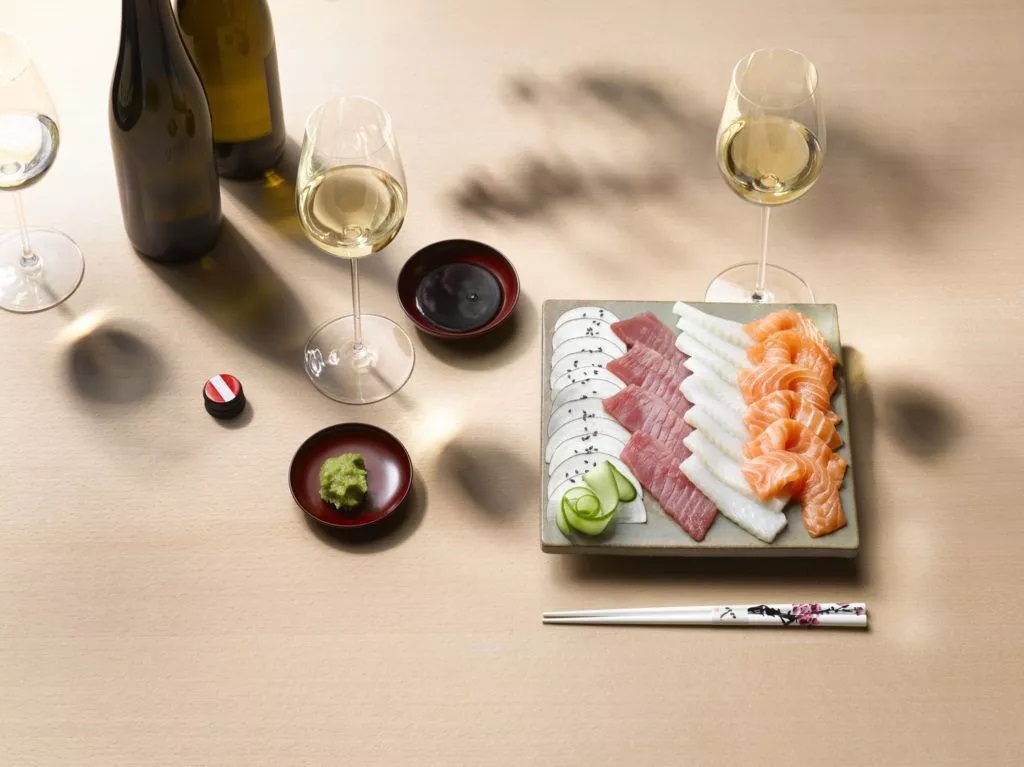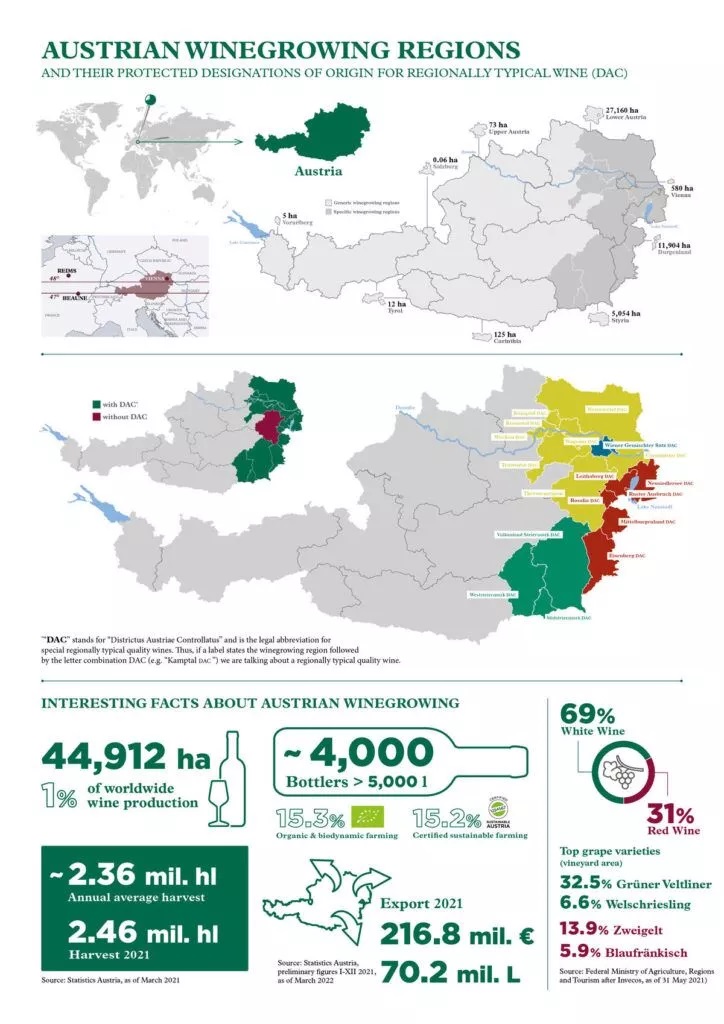Austria
Austria’s wines are now highly prized both by wine experts and wine lovers all around the world.
As artisanal products crafted by winemakers with a special link to their land, they consistently demonstrate their potential at international blind tastings. There is a distinctive tension common to all these wines which should be emphasised, based on seven factors.
Climate
Although Austria is at the same latitude as Burgundy, it is much more centrally located within Europe. It is consequently in the transitional zone between the mild and damp Atlantic climate, and the continental Pannonian one, which has much wider variations in temperature. Warm, sunny summer and autumn days with northerly, cool nights are key to the development of fresh, aromatic wines with good body and fine character. There is simply no other place on earth where the refreshing wines are so concentrated, or where opulent wines exhibit such grace.
- Continental Pannonian climate
- Moderate Atlantic climate
- Cool air from the north
- Illyrian Mediterranean climate
Terroir
Austria is a relaxed country with an unmatched quality of life. This is one of the key reasons why Austria has become a globally-renowned tourism destination.
Many holidaymakers view Austria as the most hospitable country in Europe. This is especially true for its picturesque winegrowing regions, which cover about 44,900 hectares: the Wachau and the classic regions in Niederösterreich (Lower Austria) either side of the Danube; Steiermark (Styria) and its spectacular ranges of hills; Burgenland with the natural paradise Lake Neusiedl; and Wien (Vienna) – the world’s only major winegrowing capital.
And the character of the wines is just as individual as the character of the regions they hail from. In addition to the climate, the soils are a key factor behind this individuality: crystalline stone terraces or huge loess layers in Niederösterreich, calcareous soils in northern Burgenland and Südsteiermark or volcanic soils in Kamptal and Vulkanland Steiermark. This means that, despite being a small wine producing nation, Austria offers a wide range of different, interesting wines which nevertheless all share an amazing tension between ripeness and freshness.

Grapes
Internationally successful varieties such as Riesling, Sauvignon Blanc, Gelber Muskateller (Muscat Blanc à Petits Grains), Weissburgunder (Pinot Blanc), Chardonnay, Pinot Noir, Merlot and Cabernet all ripen in particular regions and sites in Austria, producing great wines in their own right, with finesse and regional typicity.
Over recent years the great potential of old, Austrian grape varieties has become ever more apparent, and Grüner Veltliner is pre-eminent amongst these. It has long since established itself as one of the great white wines of the world and as a result it is being planted more and more frequently in other parts of the world.
At the same time, international wine experts are discovering exciting rare varieties such as Zierfandler, Rotgipfler, Roter Veltliner, Neuburger and Wiener Gemischter Satz, as well as Austria’s typical red wines made from Zweigelt, Blaufränkisch and Sankt Laurent. Austria also has truly terroir-driven jewels including rosé-coloured Schilcher from Steiermark, made from the grape variety Blauer Wildbacher, as well as the nobly, sweet Prädikat wines from around Lake Neusiedl, especially those made from Welschriesling.
Culture
For over two millennia, wine has been a part of Austrian culture. Roman cellars, medieval villages, baroque monasteries and castles are all part of the typical landscape of our winegrowing regions.
However, despite paying all due respect to its ancient traditions, Austria has now become an exciting, modern wine country with an internationally recognised depth of quality. These developments can be seen not only in the shape of outstanding wines, but also in a wave of new architecture, which has gained international attention for many wineries. Austria’s experimental “natural” wine scene is also especially dynamic.
Today’s young winemakers are building on traditional knowledge, and are combining it with the experience they have gained in oenology schools and wine estates around the world, and they are confidently treading a new path.
Nature
Austrians love nature and as a result they treat it with the greatest of respect. Environmental protection, water purity, healthy and GMO-free food, biodiversity, energy and materials efficiency are all treated with the highest priority.
For this reason it should come as no surprise that Austria is the world leader in organic farming: around 27% of the agricultural area and 16% of all vineyards are already managed according to organic farming guidelines*, a fifth of it is biodynamic**. There is also an official certification scheme for sustainable viticulture in Austria. And lastly, the majority of grapes are still harvested by hand. Despite this – or perhaps precisely for this reason – the wine industry has developed with special dynamism in recent times. The number of internationally competitive companies is growing steadily, and new names are gaining recognition beyond Austria’s borders every year. The curve of ever-increasing export turnover is similar to that of the most successful countries in the New World.
Value
Family farms dominate the Austrian winemaking scene, which is why the focus is not on mass production.
As a result of this ownership structure, and the high labour intensity inherent in artisan production methods as well as strict yield restrictions, Austria as a wine-producing country can only sell at entry-level prices in exceptional circumstances (large harvests, one-off marketing offers, sales …).
Nonetheless, Austria’s wines are excellent value for money in all the profitable price bands. Many of the 10 to 20 Euro wines offered by wineries with sales outside Austria are at quality levels which usually cost significantly more on international markets. Top Austrian wines with international reputations are especially good value. A leading American importer and wine expert put it like this: “Grüner Veltliner is the greatest value in the world of fine wine. The more you spend, the better the value.” This quote definitely also applies to other Austrian wines in the top segment.

Taste
Austrian wines have a compact body and climate-driven freshness which makes them an excellent match for an exceptionally varied range of cooking styles and cuisines: from Central Europe to the Mediterranean and beyond to Asian foods, and from ethnic food to fusion.
Numerous international tastings have proven that Grüner Veltliner & Co are also wonderful partners for Chinese and many other Asian dishes, including Japanese fare such as tenpura and sashimi.
But Austrian wine is of course firmly rooted in Austria’s wonderful culinary tradition. In short: it is the ideal match for the widest possible range of foods, from schnitzel to sushi.
Austrian Wine at a Glance
